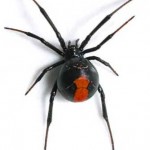Black Widow Spiders, Worthy of Fear?
By Patricia Hottel, BCE
In a 2013 survey released by the Professional Pest Management Alliance, spiders were ranked as the third most important pest by consumers behind ants and termites. Most structures have at least an occasional spider and they are familiar pests. Although common, spiders can elicit a variety of responses from acceptance to fear. Despite their reputation, very few spiders are of medical concern. Common spiders which are capable of causing illness in the United States include: the black widow spider, brown recluse spider, and brown widow spider. Black widow spiders can be found all over the U.S., brown recluse spiders are primarily found in the central states such as Kansas, Missouri, Kentucky, Tennessee, Oklahoma, Texas and Arkansas. The brown widow spider, a relative of the black widow, is more common in the Southeast but may be associated with plants and shipped into different parts of the United States on nursery stock.
There have been several recent reports of black widow spiders being found in grapes purchased in supermarkets. These spiders make their way on shipments from California or other grape growing regions into the stores. Cases were recently reported in Michigan and Wisconsin. Although black widow spiders are poisonous and can cause illness, the relative risk to people has been exaggerated as is the case with most spiders. Most spiders are harmless. Those capable of causing harm, rarely bite and when they do, there are few fatalities.
Some important facts about black widows regarding identification and their medical importance:
- Black widows are considered the most venomous spider in North America and it has been reported that their venom is 15 times more toxic than a rattlesnake. However, due to their small size, the amount of venom injected is relatively small. Although this spider is considered deadly, only 1% of those bitten die. As with many medical conditions, small children and the elderly are more likely to suffer more serious health effects than the general population.
- Black widow spiders are not aggressive and bite in response to self defense.
- Symptoms produced by the bite include nausea, muscle aches and difficulty in breathing.
- Anyone who believes they have been bitten by a black widow spider should try to capture the specimen for positive identification, apply ice to the bite site and seek medical attention. There is an anti-venom available.
- Black widow spiders can live 1-3 years in the wild and are relatively long lived.
- The spiders can be identified by their color and size. They are approximately 1.5” in length (including the legs), shiny jet black in color with a red hour glass on the underside of the abdomen. This hour glass can vary somewhat in pattern and color.
- The female will construct a web for capturing insects and other prey and webs can be used to recognize spider activity. The female will lay her eggs in round silken sacs which may be seen on the web.
Control efforts for black widow spiders should be aimed at exclusion and removal of clutter. Webs, spiders and spider egg sacs can be vacuumed up for physical removal. As a precaution, gloves should be worn when handling items where black widow spiders are suspected such as fire wood, and storage boxes.

